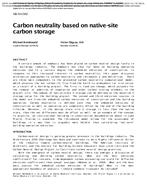Description
A certain amount of emphasis has been placed on carbon neutral design lately in the buildings industry. The emphasis has thus far been on building operation emissions and to a certain degree the embodied emissions of construction. In response to this increased interest in carbon neutrality, this paper discusses alternative approaches to carbon neutrality and introduces a new definition. There are three main components to the presented carbon neutrality computational model, which assesses the net carbon (C) flux from the Earth to atmosphere (or vice versa) as a result of a building project. The first is land use change, which accounts for the removal or addition of vegetation and other carbon storing elements to the project site. The amount of native-state C storage can be defined as the baseline C storage value for the building project. The second and third emissions sources in the model are from the embodied carbon emissions of construction and the building operation. Carbon neutrality is defined such that the embodied emissions of construction as well as operation are completely offset by the end of the building lifetime. Moreover, if the design state site C storage is less than the native state, than the net difference must be offset as well. As an example of the concept in practice, an institutional building in construction documentation phase in Lake Placid, Florida is examined. The introduced model allows for the assessment of buildings in a way that is arguably more helpful than calculating “net-zero†building operation emissions.
Citation: ASHRAE Conference Papers, 2010, vol. 116, pt. 2, Albuquerque, NM
Product Details
- Published:
- 2010
- Number of Pages:
- 9
- File Size:
- 1 file , 610 KB
- Product Code(s):
- D-AB-10-C002




